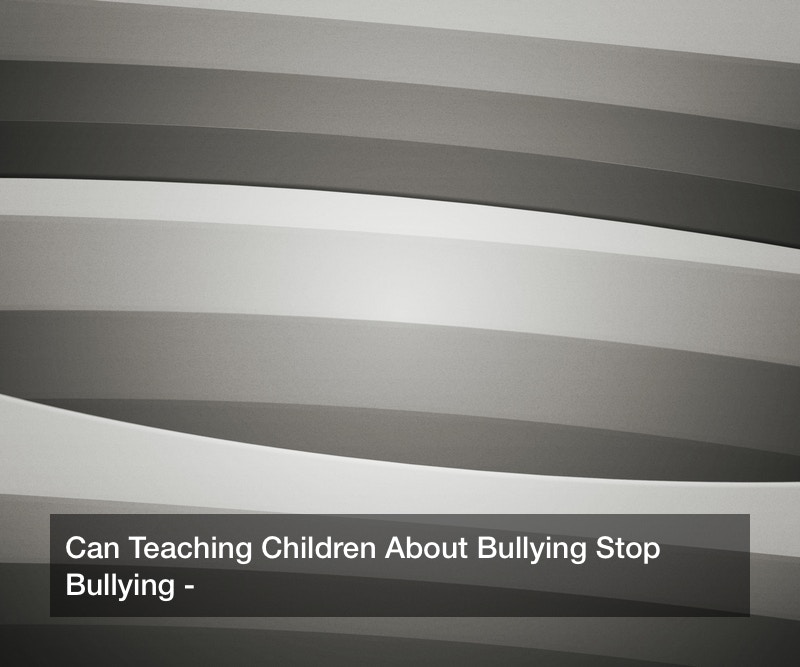
There is a new awareness about teaching children about bullying. Bullying and the ill effects of this behavior have taken center stage in schools, clubs, and even in children’s television programming. Teaching children about bullying has become a society-wide responsibility in light of recent events.
Teaching children about bullying, can help to prevent this type of behavior. There has been some very upsetting fallout from bullying that has increased the urgent need to focus on teaching children about this negative behavior, and how to get help if they are being bullied.
Sticks and Stones

The old saying “sticks and stones make break your bones but words can never hurt you” was often used to dismiss name-calling and abusive language as something that could be ignored. Unfortunately, children that are being bullied by name-calling often would prefer if someone was throwing rocks and sticks at them.
Children can be cruel and the things that they say to each other can be heartbreaking to hear. Children are often made fun of for simple things like a new hair style. While it may not seem like a big deal for one child to make fun of another’s hairstyle, it can cause emotional scars that are very hard to heal from.
Making light of the problem, or just suggesting that a child ignores the bullying, is not the right solution. It is important that the problem is addressed, and that the child feels heard, and steps are taken to stop the abuse.
Teaching kids about bullying can help to control the problem. Talking to parents, getting the authorities involved all can be meaningful ways to control the problem. Words do hurt, and bullying is not acceptable.
It is An Epidemic of Bad Behavior
Unfortunately, bullying is not just a childhood epidemic, it has spilled over into a tremendous societal problem. Adults are bullying other adults. Social media has made it easy to say hateful and hurtful things about groups, individuals, and anyone that you want to coerce or intimidate.
Teaching children about bullying can help to create adults that keep a lid on the hate. There have been incidences of adults being bullied for wearing braces. A family lawyer recounts a story about a parent that went on a social media bullying rampage because they were trying to convince the other parent to agree to their new terms in court.
This lawyer goes on to explain how the former spouse dragged out all the dirty laundry they could on their ex-partner because they wanted the ex to agree to a lower child support agreement. The ex had to deactivate all of your social media accounts, and basically go into hiding not to have to answer questions or deal with the humiliation. It went on for months and took a true toll on both the ex and the child.
There have been numerous reports of young people committing suicide because they could not deal with the bullying both online and off. Social media has made bullying easier. It has given people a feeling of anonymity and the ability to say whatever they want and feels protected.
Bullying is at epidemic proportions in schools. Catholic schools, public schools, private schools, no school has not experienced an increase in bullying. Social clubs and other extracurricular organizations also report an increase in this behavior.
A lot of parents put a lot of effort into finding the best schools for their children thinking that they will be safe and cared for when they go to school every day, but no school is completely void of bullies. Whether you are considering a charter school that is for gifted artists or you are considering a public school, you should ask the school about what they are doing about teaching children about bullying.
Teaching Your Children About Bullying When They Are Being Bullied

It can be difficult to recognize when your child is being bullied. There are some signs that children will display if they are being bullied that you can look for to ensure that your child is safe:
- There items suddenly start disappearing. Electronics are missing and other items disappear. Bullies will often intimidate other children to get things from them.
- They come home with torn clothing. Bullied children are often pushed and pulled which can tear their clothing.
- Unexplainable scrapes, bruises, cuts, and other injuries. If your child has mysterious injuries and will not tell you how they got it, they may be afraid to tell you what happened.
Other signs that your child may be being bullied include missing articles of clothing. A change in behavior, like not wanting to go to school, refusing to eat, being angry all the time, lashing out at younger siblings.
Children are often afraid to identify their bully because their bully has access to them when adults are not around to provide protection. In some cases, children have identified their bully to a teacher or other adult but nothing was done about it.
If you suspect that your child is being bullied and there have been physical injuries, make an appointment with your family doctor to document those injuries. Do not upset your child further by constantly digging and trying to get confirmation. They will tell the details when they are ready. It is important to start a paper trail.
Contact the school counselor if you feel that the events are taking place at school. Ask the counselor what they are doing about teaching kids about bullying, and if there is any way they can talk to your child’s class about bullying.
If a call to the guidance counselor does not seem to alleviate the situation, call the principal, if that does not help go to the school board. If all of your efforts does not change things for your child, hire an attorney.
It is important that your child sees that there are ways to fight back and that you are willing to help them fight back. The only way to put an end to their torment is to fight back by any means possible.
If your child is displaying behavior problems or a sudden loss in the things that they enjoy, get them professional help. It is important that you acknowledge that your child can be under very real duress if they are being bullied. The emotional pain of bullying can be tremendous for anyone, but especially for a child. It is the kind of pain they can carry around their entire life if help isn’t offered to navigate the feelings.
What can you do to make things easier on your child why the bullying situation is getting under control? One of the best things you can do as a parent to help your child manage the situation is just to listen, and keep teaching children about bullying. Treat every moment as a teaching moment. When you are watching TV together point out bad behavior and how unacceptable you think that is.
Share your experiences with your child. Have you ever come across a bully? How did you handle it? Sharing your experiences with your child can get them to open up to you and help them to feel like they are not alone in the situation.
What Should You Do If You Think Your Child is Bullying Someone

In some cases, you are at the other end of the spectrum and you are the parent of the bully. What do you do when you realize that your child is the bully? Once you get past the shock, teaching children about bullying should be your first priority.
Delving into what is happening with your child that is making them lash out at other children is your first order of business. You want to remain calm, and listen intently to their side of the story. In many cases, what is reported as bully behavior is more of a disagreement between two children and one child bests the other one in the argument. The loser reports the problem as a bully incident. Take a deep breath and listen to your child’s perception of the situation.
A guidance counselor related this story. Evidently Jason and Gregg were pretty good buddies, Jason had to have some orthodontic treatment that resulted in braces. Gregg made and offhanded comment about Jason’s braces, and Jason responded by calling Gregg fat. While the friendship was on the rocks, Jason continued to make comments about Gregg and his weight every time he passed in the hall, making Gregg feel terrible.
After a couple of weeks, of this behavior, Gregg was really feeling terrible, and turned to the guidance counselor for help. The counselor set up a session for the two boys, where Jason broke down in tears about the braces comment that Gregg had made, and explained he was so hurt and upset that he just wanted to get even with Gregg. Jason said every time he said something to Gregg about his weight when he passed, Gregg would just give him a big smile. Jason took it as Gregg was taunting him about his braces.
The moral of the story is that just because your kid seems to be targeting another child it does not mean that you are dealing with a “bad kid”, they may be angry, or they may perceive the situation from a totally different angle.
Here are some other tips to help you deal with your child if you think they are displaying bully behavior:
- Notify the school. Talk to the counselor and the teachers to let them know that you suspect your child is acting out, and it is not something you support. You cannot be with your child 24 hours a day to keep an eye on their behavior having other adults on your side can help.
- Model good behavior. Children learn what they live. Show empathy and let them see you expressing your distaste for bully behavior.
- Require restitution. Restitution is not a punishment it is simply paying for what you did. Make them apologize, make them pay for anything that they broke.
With very young children often bullying behaviors crop up because the other child has something that they want. Acknowledging that you understand that they want it, then refusing to get for them because of their behavior can be a valuable lesson.
Many parents make the mistake of rushing out to buy whatever it is the child wants to try to control the behavior. Throwing money at the problem will not solve the problem. Americans are about 1 trillion dollars in debt, you do not need to add to that number trying to buy good behavior.
Teaching moments arise when you least expect them. Teaching children about bullying can happen anywhere.Kristie sensed that her little girl was picking up bully behaviors when they were watching TV one day, right after she told her daughter she could not have another ice pop so close to dinner, and a commercial came on for meal replacement for athletes. It was mentioned in the commercial that it could also be an option for weight control, and her little girl piped up “Mommy you are fat, you should be doing that, no one likes fat people, everyone would like you better if you were thin.”
Kristie had never said anything about her weight in front of her daughter, nor had she ever talked about dieting, but she had been complaining to her husband that her weight was bothering her. Her daughter had picked up on the idea that her weight was a problem for her, and used that to hurt her mother’s feelings because she would not give her the ice pop she wanted.
Kristie immediately used the situation as a teaching moment and had a discussion with her daughter about being mean when you could not get your way. She also decided right then and there that she would look for materials on teaching children about bullying that could help her teach her daughter about bullying and how to control those behaviors.
Educating Children and Modeling The Right Behavior is Key

Whether your family is dealing with the receiving end of bullying or your child is the bully, the best way to deal with the problem is through education, and modeling. Children look to adults and the larger society to show them the rules of how to live.
Teaching children about bullying helps them to understand how detrimental this behavior is. Teaching children about bullying may be the key to stop bullying.




